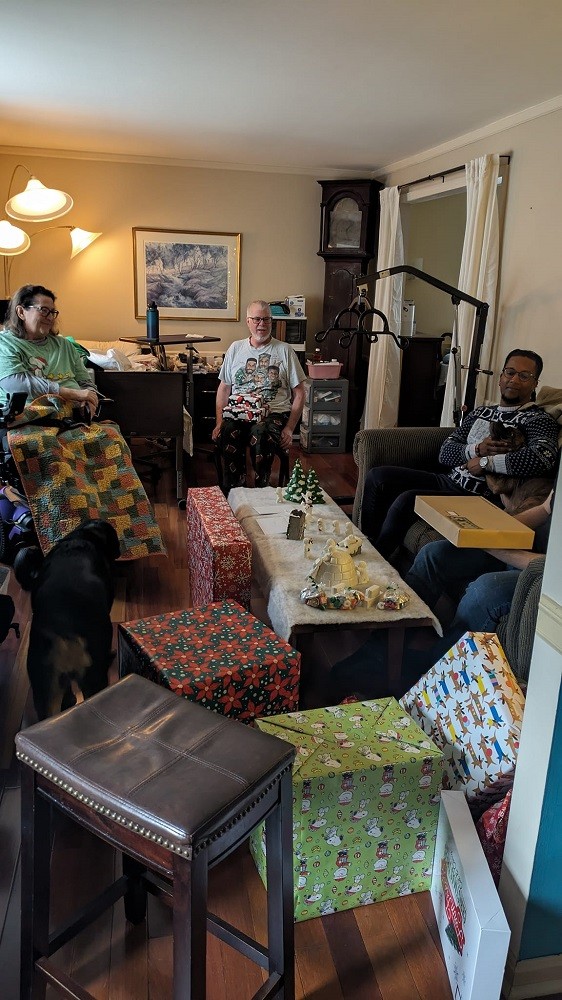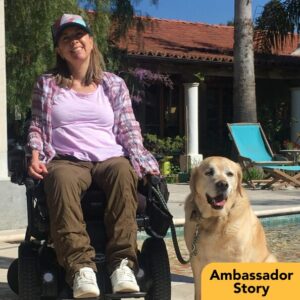62-year-old Jena Cavanagh turned to Help Hope Live for fundraising after a March 2023 back surgery left her with a paralyzing spinal cord injury.
Facing insurance hurdles and income restrictions, Jena was forced to fundraise just to continue living in her own home with her husband. This is her story.

Before March 2023, I was a bit overweight but otherwise in good health. I loved to be outside in my flower gardens and trimming bushes—this is when I was my happiest.
I spent weekends gardening and cleaning, and I went to see my mom every weekend to help her clean, go shopping, and go out to eat—traveling an hour each way to visit with her. I also enjoyed freely interacting with my two dogs, Jax and Silas.
I am no longer able to do any of those things.
My first thought following my diagnosis was, Oh my God—I will have to work hard to recover from this.
I recalled my experiences from two prior back surgeries and two knee replacements. I believed I would recover and return to my normal life.
It wasn’t until I got to rehabilitation that I was able to fully review and research the diagnosis and talk with the doctor and physical therapist.
That’s when I realized that I would not recover.
My paralysis was deemed complete, and I am living with paralysis from the armpits/chest down. I have rods, plates, and screws from my C3 vertebrae down my spine into my pelvic bone.

The biggest change has been my lack of ability to visit family and friends or go to work and see co-workers. I had to retire from my career due to this injury.
I also miss having access to the second floor and basement of our home, though I appreciate the renovations that have given me access to the first floor and back deck.
My family has stayed in contact with me, and my interest in gardening has stayed the same—but at this point, I’m more often providing directions for what I’d like done rather than doing it myself.
My friendship with my co-workers has remained the same, too. They are wonderful people.
My dogs still love me, especially when I have treats.
Hope Is Living at Home
My greatest priority is to continue to live in my own home with my husband, Steve. Steve and I have always loved the community we live in.
In June 2023, I was able to return home from a skilled nursing facility after my husband worked with a contractor to add a concrete ramp to the front door, a new back door, and a new deck ramp so I had a second exit from the house in case of emergency. The shower was renovated for access and a new bathroom sink was put in so I can roll up to the sink to brush my teeth and wash my face and hands.
To me, hope means being able to continue to manage my health issues and live at home.

A Career Serving the Disability Community
I had prior experience with rehabilitation and disabilities.
I graduated in 1984 with a degree in therapeutic recreation, and I worked for five years as a residential and day treatment provider. I worked primarily with individuals with an intellectual disability (ID) diagnosis.
I served as the program director for three homes, staff, and residents. I transitioned to being a caseworker for the next 10 years for individuals who lived on their own with assistance and individuals who lived in community homes following institutional living.
I then spent 22 years as an ID county program specialist.
I loved these years in my career. I worked with a wonderful team of people, and I felt good about being successful solving problems for individuals living with ID.

I also served as a point person for a local lifesharing program, which allows individuals living with ID to live with a trained support professional and remain in close contact with their family and community.
That was important to me, because in my experience, lifesharing was the best residential service for individuals who couldn’t live with their family or on their own. I was able to give local and state conference informational sessions about lifesharing. Individuals with ID were able to live with a supportive family instead of in a community group home.
My co-workers have kept in touch with me, and I periodically call to catch up on what’s new at the office. A few of my co-workers who have retired visit with me monthly for lunch dates. Though my career cannot continue as I planned, I do plan to get re-involved with a local lifesharing coalition.
Spending 30-plus years in this field of work definitely influenced my experience of life after SCI.
I thought to myself, okay, I can manage this better because of my work history. In some ways, that has worked out—for example, it’s been easier for me to tackle the process of applying for and managing SSDI benefits.
However, in other areas, the same frustrations still apply—such as in challenges scheduling doctors appointments and follow-up care, and in major barriers I’ve faced in securing reliable and safe transportation.

The True Cost of Life with SCI
Even though I had a background in these areas, we had no idea of the fighting and advocacy it would take to get insurance to cover my care after SCI.
In addition to the out-of-pocket costs of home modifications for accessibility, some of our other expenses include caregivers and care items such as briefs, bed pads, gloves, and wipes.
Physical therapy, occupational therapy, and a visiting nurse need to all send monthly requests to my insurance since the insurance company doesn’t cover long-term care. Due to the inconvenience and loopholes insurance makes you go through, it’s hard to find providers that will accept it.
For long-term aid agencies, Medicare is the only insurance they’ll accept. I won’t be eligible until March 2025.

I don’t qualify for Medicaid because of my SSDI and my retirement income. This was a surprise to me: I assumed that I’d be eligible for an aging waiver program through Medicaid.
I am also not eligible for any local funded services because of my income: our resources cannot stay within the combined income monthly limit of $3,000.
I’ll never be eligible for certain services due to our income. That means I’ll have to worry about how I’ll pay for ongoing health costs, supplies, and caregiving for the rest of my life.
If we can’t meet that financial burden, I’ll have to be admitted to a nursing home. Even then, on a monthly basis, I will have to pay the nursing home out of my monthly SSDI and my retirement. I will be allowed to have only $30 per month free for spending on “personal needs.”

In addition to these coverage challenges, we have to fight to get items covered that insurance doesn’t deem a medical necessity.
One example is a shower chair:
For insurance, getting sponge baths for the rest of your life after SCI is all you need—so a shower chair doesn’t qualify as medically necessary.
One last unexpected cost we face is hospital transportation. It takes approximately six months to get insurance to cover a single emergency ambulance trip to the hospital—which is supposed to be a covered service.
Forced to Fundraise: The Impact of Community Support
I knew I needed to start asking for help, because the cost of SCI care and supplies is expensive and ongoing.
I chose Help Hope Live because I knew that people could make tax-deductible donations in my honor.
I learned about Help Hope Live because my niece, Michelle Hernandez, started a campaign for costs associated with cystic fibrosis. Michelle had a good experience, and I knew from her that Help Hope Live had a good reputation.
I’d recommend to anyone coming to Help Hope Live for fundraising to not be afraid to share your story or ask for help.
The response from the community has been positive. I have been so appreciative of donations from co-workers, providers, friends, and family members.

Funds raised have enabled us to renovate our house so I can continue to live at home, and they have helped us cover the cost of caregiving for the past 18 months. However, I have to continue to fundraise to meet ongoing health and caregiving expenses.
I’ve found that the emotional support of family and friends has been much more effective than I ever expected. The support of the community is really important, and that is something Help Hope Live provides for all who need it.
I know that living at home is a luxury, and there are others in my shoes without this kind of support who don’t have this privilege.
I can’t imagine what my day-to-day life would be like without the donations in my honor graciously made by my community so far.

Support ongoing fundraising efforts in honor of Jena at helphopelive.org and keep up with her on Facebook.










